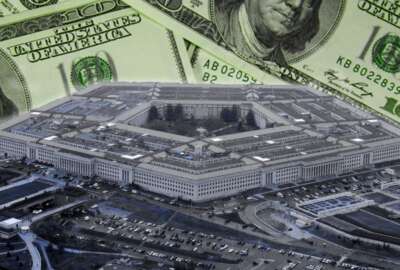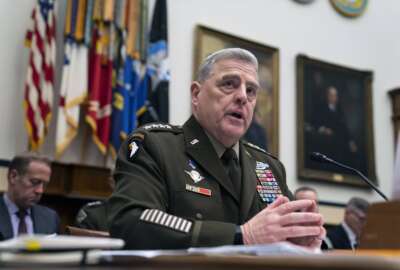Is spending on American defense too much or perhaps not enough on the right things
Whether you think the U.S. defense budget is too big or two small, one thing is for sure: The planned increase in spending doesn't keep up with inflation. For more...
Whether you think the U.S. defense budget is too big or two small, one thing is for sure: The planned increase in spending doesn’t keep up with inflation. For more on that, Federal Drive with Tom Temin talked with someone who says there are ways to reallocate the $800 billion odd dollars to get more capability, Heritage Foundation Senior Policy Analyst Wilson Beaver.
Interview Transcript:
Tom Temin And you have written that because it can’t keep up with inflation and there is political disagreement over how large it should be. Somehow the two sides, roughly there’s probably 50 sides, but the two basic sides have to come together and find ways to help it keep up with inflation in terms of power that can be put on the front if needed, correct?
Wilson Beaver Absolutely. For the next two fiscal years, at least, top line increases are likely to be pretty modest. So if we want a military that’s increasing in capability, buying more ships, buying more planes, munitions, all the sort of stuff that military actually uses, what we need to be cutting is non-defense spending that’s currently hidden inside the DoD budget, stuff that does not increase military capacity, but just serves a variety of other purposes that are secondary.
Tom Temin Yes. And you cite in particular research and development. The military says, and the Pentagon leadership says that, well, the only way we’re going to get to that next strategic offset is their word is with R&D that we spent similar to the seventies and eighties and developed all these technologies that are now wearing out in terms of their ability to give an advantage. So now AI is a lot of spending and I guess maybe new ways of stealth and so forth. There’s got a lot of things going on. They need that, though, don’t they?
Wilson Beaver Right. But the problem is that they’ve been saying that for so long that RDT&E research and development has almost caught up with procurement. Can you imagine if Ford was spending as much on research and development as they were on building cars? It doesn’t make any sense. It is important. There should be money spent on it, but it could absolutely go down and be reallocated to buying ships and planes. And at a certain point, you have to build in the generation you’re in. You can’t always be cutting programs halfway through and then working on the next thing.
Tom Temin Yeah, they say, what is it? Procurement is deterrence in some ways, I guess was kind of the philosophy behind that. But then you get into the issue of the new generation of platforms are also really, really expensive and take a long time. I mean, a carrier is almost 15 or 20 years from when you lay the keel to when it can actually be operationally deployed. And we know the cost of the submarines and the new fighters that 20 years in still really don’t quite work. And so they’ve got to do something on that front, too. Fair to say.
Wilson Beaver Fair to say. There’s an old adage that you should really only add one or two major tech upgrades to a new program. The Ford had at least six major tech upgrades and it spent the past year or two trying to iron them all out. I do think they’re making progress and by the time the next two carriers are launched, I think a lot of those problems will be ironed out. But like you said, it takes a while and putting all that stuff in upfront, can cause problems.
Tom Temin You know, and right now there is the threat of a federal shutdown. And so lots of budget arguments going. And I wanted to ask you, while we have you too, in your experience looking at the defense budget, federal lapses in appropriations, how does that affect DoD? I mean, often the brass are saying that when they have a continuing resolution, that in many ways cripples their progress that they’re trying to get to from year to year. What about a shutdown?
Wilson Beaver For sure it does cause problems. The biggest one is that it sends mixed messages to the people that are building stuff and buying stuff for the DoD. If they’re not sure when their next paycheck is coming in, then it can be hard for them to make long term plans, building missiles or building ships. But we are happy that all the negotiated budgets do leave defense alone, at least, and cut elsewhere. Because we think that these are priorities for the United States, that the security United States is best served by a capable military. The National Defense Strategy says that a pacing challenge from China is its number one priority. And if that challenge is going to be met, it’s going to require ships and munitions and all of that.
Tom Temin We’re speaking with Wilson Beaver. He’s an Army veteran and senior policy analyst at the Heritage Foundation. Again, getting back to what you mentioned as a major discretionary item that could be reallocated, and that is research and development. But what else in there is really left to reallocate because of the high fixed costs that the Defense Department has. I keep harkening back in these types of interviews to what Secretary Bob Gates said years ago, that the costs of personnel, particularly health care costs, both current and long term for the volunteer force. He said they’re eating us alive. And as you increase force structure, which right now there’s no real momentum in Congress to do that. But even as you do, those long term fixed costs go up and how do you get around that without some fundamental increase in the budget in real terms.
Wilson Beaver So personnel costs, it’s true they’re high, but I’ve always thought that the well-being of the troops should be the absolute last place to look for savings, especially when there are so many other inefficiencies to be found within the DOD budget. One of them would be base closings, BRAC. But it’s politically contentious because there’s always at least one congressman that wants to defend that base. The Pentagon asks for it repeatedly, but actually, at this point, they’ve stopped asking because it is so politically contentious within Congress. There has to be some wider recognition that if the military says a base isn’t needed any more, then you should at least consider closing it.
Tom Temin And you also find that within the weapons systems they are planning to procure, that could be redone in a way that puts more tooth in the direction of what they say is their pacing challenge, which is China and what it could do in Taiwan.
Wilson Beaver For sure, all defense procurement should be informed by strategy. We shouldn’t be buying stuff that doesn’t match the strategic intent of the Department of Defense as directed by the president and the Congress. And if the Indo-Pacific is where we are supposing that most future military operations will take place, then that’s going to be a lot more funding for the Navy and Air Force and a lot more money spent on long range munitions and ships and a lot less on the stuff that we’ve been using in Iraq and Afghanistan for the past 20 years.
Tom Temin Yeah, somehow the army always seems to take it on the chin when these force projection ideas.
Wilson Beaver Which I hate because I was in the army, I hate to say it, but if that’s the strategy, then the Navy and the Air Force definitely need more funding.
Tom Temin And within procurement itself, there is a lot of inefficiency and the way programs just seem to get ever more complex and costly and further in the future. The F you know what is always cited as the prime example of that, but it’s not alone in that type of dynamic.
Wilson Beaver It’s not alone. And as F-35 purchases increase, costs will decrease over time. One of the best ways to decrease costs is with block buys. Like you were saying earlier, appropriations year every year sends mixed messages to industry and makes it very hard for them to plan long term, which drives up costs. One pretty helpful thing in the NDAA being discussed this year is block buys of munitions. All these missiles needed for the Pacific Ocean are being bought years out instead of just bought for this year. And that’s going to drive prices down and it’s going to send a long term message to industry that the DoD is going to keep buying this stuff.
Tom Temin And you make a statement to finish up here that basically the hawks and the doves, as they used to be called many years ago in the Scoop Jackson days, somehow have to find common ground. And what’s your handicap on that ever happening?
Wilson Beaver I wouldn’t bet too hard on any broad cooperation in Congress. But I do think that there is potential for fiscal hawks and defense hawks to team up if defense hawks want a stronger military. They want it focused on the biggest challenge, which is the Indo-Pacific. And the fiscal hawks want the public to save money. They want taxpayers dollars to be well spent, and there are savings to be found in DoD. We’ve actually identified a lot of other ones in a previous report, like 40 pages long, full of recommendations, all sorts of budget cuts that can then be put into more worthwhile endeavors. So the public’s money is being well spent.
Copyright © 2025 Federal News Network. All rights reserved. This website is not intended for users located within the European Economic Area.
Tom Temin is host of the Federal Drive and has been providing insight on federal technology and management issues for more than 30 years.
Follow @tteminWFED







